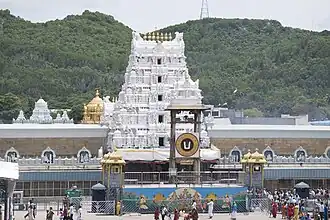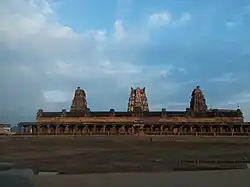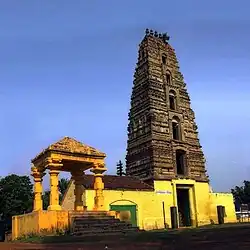Bugga Ramalingeswara Swamy Temple
| Bugga Ramalingeswara Swamy Temple | |
|---|---|
బుగ్గరామలింగేశ్వర స్వామి ఆలయం | |
 Bugga Ramalingeswara Temple, photographed c. 1868 by Edmund David Lyon | |
| Religion | |
| Affiliation | Hinduism |
| District | Anantapur district |
| Deity | Lord Shiva |
| Location | |
| Location | Tadipatri |
| State | Andhra Pradesh |
| Country | India |
| Architecture | |
| Completed | Between 1490 and 1509 |
Bugga Ramalingeswara Swamy Temple (Telugu: బుగ్గరామలింగేశ్వర స్వామి ఆలయం) is a Shiva shrine situated on the southern bank of the Penna River in Tadipatri, Anantapur district of Andhra Pradesh, India.[1] It was built between 1490 and 1509 by Pemmasani Ramalinga Nayudu I, a chieftain of the Gutti-Gandikota region during the reign of the Vijayanagara Empire.[2]
The presiding deity is a linga, considered to be ‘swayambhu’ (naturally occurring or self originated).[1] The temple has seven small independent pillars in front of the Vishnu shrine and when struck they produce 'saptaswara' (the seven musical notes).[3] The gopurams of the temple are unfinished and were described by architectural historian James Anderson as ‘wonders’.[4]
Description
Bugga Ramalingeswara Swamy temple is 4 km (2.5 mi) from Tadipatri railway station. It was likely built between 1490 and 1509 during the reign of the Vijayanagara Empire.[2] As per the Tadipatri kaifiyat collected by Colin Mackenzie in 1802, the temple was built by Ramalinga Nayudu, a chieftain of the Gutti-Gandikota region in Vijayanagara Empire.[2]
The temple consists of a sanctum, ardhmandapa, and mukhamandapa in an axial line. The temple contains bas relief structures illustrating episodes from Ramayana and Mahabharata. The presiding deity (linga) being a ‘swayambhu’ (naturally occurring or self originated).[1] Unlike other Hindu temples where the deities are east-facing, in this temple the Shiva linga faces west.[4] When struck, the seven pillars in front of the Vishnu shrine produce 'saptaswara' (a musical scale).[3]
The architectural historian James Anderson described the gopurams of this temple as ‘wonders’.[4]
Gallery
-
Entrance to Garbhagudi
-
Unfinished gopuram
-
Unfinished gopuram
-
Musical pillars
-
Rocks used for construction
-
 Inside the temple
Inside the temple -
 Panoramic view of the temple
Panoramic view of the temple -
.jpg) Temple carvings
Temple carvings
References
- ^ a b c Arch. Series. Government of Andhra Pradesh, Department of Archaeology. 1960.
- ^ a b c Reddy, V. K. Rakesh (10 August 2015). "Apathy hits Bugga Ramalingeswara Swamy temple". The Hindu. ISSN 0971-751X. Retrieved 24 October 2020.
- ^ a b Bhaskar, V. S. "District Census Handbook, Anantapur, Part XII-A & B, Series-29". p. 21.
The seven small independent pillars in the temple when touched produce 'Saptaswara' (the seven musical notes).[1]
- ^ a b c "Bugga Ramalingeswara Temple: Visit this offbeat gem from the Vijayanagara era". www.beontheroad.com. Retrieved 25 October 2020.
External links
- https://www.inrootz.in/historic-places/religious-spiritual-temples/pl60/Bugga-Ramalingeswara-Temple-Tadipatri-Anantapur
- "Tadipatri - Bugga Ramalingeswara Swamy Aalayam". hindubooks.org. Archived from the original on 20 August 2017. Retrieved 12 September 2016.
- "Bugga Ramalingeswara Swamy Temple - Tadipatri, Anantapur". trawell.in. Retrieved 12 September 2016.
- "Sri Bugga Ramalingeswara Swamy Temple in Tadipathri | Anantapur | Andhra Pradesh". yatrastotemples.com. Retrieved 12 September 2016.


